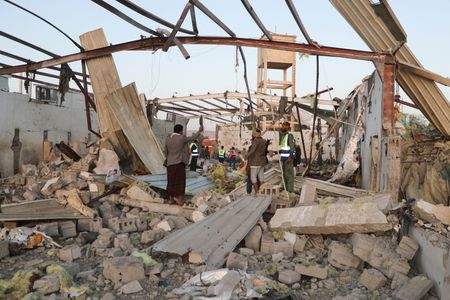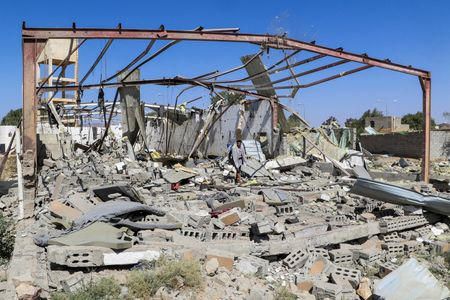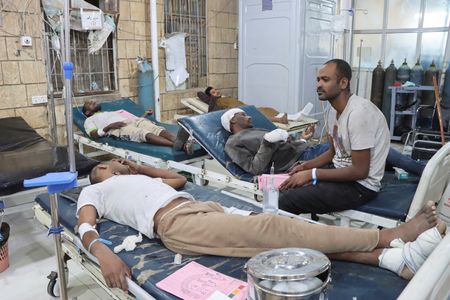By Mohammed Ghobari and Nayera Abdallah
ADEN/DUBAI (Reuters) -Corpses covered in dust and debris were scattered in the wreckage of a detention centre for African migrants in Yemen, after what Houthi-controlled television described on Monday as a U.S. airstrike that killed 68 people.
The attack was one of the deadliest so far in six weeks of intensified U.S. airstrikes against the Houthis, an Iran-aligned group that controls northern Yemen and has struck shipping in the Red Sea in what it says is solidarity with the Palestinians.
A U.S. defence official, speaking on condition of anonymity, said the U.S. military was aware of the claims of civilian casualties.
“We take those claims very seriously. We are currently conducting our battle-damage assessment and inquiry into those claims,” the U.S. official said.
The U.S. military has said it will not give detailed information about targets of its airstrikes for reasons of operational security.
Houthi-run Al Masirah television showed images of the aftermath of the strike in Saada, on a route used by African migrants to cross impoverished, conflict-riven Yemen to reach Saudi Arabia.
The footage showed bodies covered in dust amid blood-stained rubble. Rescue workers carried a man who was moving slightly on a stretcher. A survivor could be heard calling “My mother” in Amharic, the main language of Ethiopia.
Other survivors interviewed by Yemeni television in hospital described being awakened by the dawn blast. “I was thrown into the air and fell to the ground,” one said.
The American administration had committed a “brutal crime” by bombing the Saada detention centre which held more than 100 undocumented African migrants, Houthi spokesperson Mohammed Abdulsalam said on X.
The group vowed to continue its attacks on Red Sea shipping in a statement from its military spokesman Yahya Saree.
Reuters was able to verify the location and timing of the aftermath video through visible landmarks, such as a warehouse-like building with a shredded corrugated roof. Satellite images of the same location the previous day had shown the roof intact.
The location matched that of a migrant centre that had also been hit in a previous Saudi-led airstrike in 2022.
“It is unthinkable that while people are detained and have nowhere to escape, they can also be caught in the line of fire,” Christine Cipolla, the head of the International Committee of the Red Cross’ delegation in Yemen, said.
The deadliest U.S. strike on Yemen so far came this month with an attack on a fuel terminal on the Red Sea that killed at least 74 people.
The U.S. military has said it has struck more than 800 targets since the current operation in Yemen, known as Operation Rough Rider, started on March 15. The strikes, the U.S. military said, have killed “hundreds of Houthi fighters and numerous Houthi leaders.”
On Monday, the U.S. Navy said that an F-18 aircraft and its tow tractor fell off the USS Harry Truman aircraft carrier, which has been aiding strikes in Yemen from the Red Sea.
A U.S. official, speaking on the condition of anonymity, said that initial reports were that the Truman made a hard turn because of a Houthi attack in the vicinity, but it was unclear if that had caused the F-18 to fall overboard. The Houthis have regularly attacked U.S. warships in the area, but none have been successful.
The Houthis said in an earlier statement on Monday that they targeted the aircraft carrier and its associated warships in response to what the group described as the U.S. massacres against civilians.
Rights advocates have raised concerns about civilian killings. Three Democratic senators wrote to Pentagon chief Pete Hegseth on Thursday demanding an accounting for loss of civilian lives.
“Strikes pose a growing risk to the civilian population in Yemen,” U.N. spokesperson Stephane Dujarric said on Monday. “We continue to call on all parties to uphold their obligations under international humanitarian law, including the protection of civilians.”
DANGEROUS ROUTE
A civil war in Yemen has raged for a decade between the Houthis and a government that controls the south, backed by Arab states, although fighting had eased for the past two years following a truce between the Houthis and Saudi Arabia.
Hundreds of thousands of people seeking to escape poverty travel each year through the Horn of Africa and across the Red Sea to journey by foot through Yemen to the Saudi border, aid agency officials say.
More than 500 people drowned crossing the Red Sea last year as they tried to reach Yemen, according to the International Organization for Migration, a United Nations agency.
The Yemeni-Saudi border, which stretches west to east across a humid coastal plain, rugged scrub-covered mountains and high desert dunes, was an active frontline in the war for years and remained dangerous even after the truce paused major fighting.
Human Rights Watch reported in 2023 that Saudi border guards had used explosive weapons and gunfire to kill hundreds of Ethiopian migrants, including women and children, trying to cross the border. A Saudi official rejected that report.
Saudi Arabia, the world’s biggest oil exporter, has tried for years to reduce the number of undocumented migrants entering and working there, often in low-paid jobs. U.N. studies have shown it is home to an estimated 750,000 Ethiopians.
(Reporting by Nayera Abdallah and Tala Ramadan in Dubai, Mohammed Ghobari in Aden, Idrees Ali and Phil Stewart in Washington, Andrew Mills in Doha, Tiffany Le in Beijing and Dawit Endeshaw in Addis Ababa; Writing by Angus McDowall; Editing by Peter Graff, Andrew Heavens, Mark Potter, Matthew Lewis and Sonali Paul)













